The government has introduced the Captive Elephant (Transfer or Transport) Rules, 2024, which ease restrictions on transferring elephants within or between states.
Captive elephants
|
|---|
 When the current owner is unable to adequately care for the elephant.
When the current owner is unable to adequately care for the elephant.| The Wild Life (Protection) Act, 1972 : Earlier, this act was responsible for safeguarding all wild animals, their habitats, management, and regulation of their trade.
Wildlife Protection Act amended 2022: The Wild Life (Protection) Act, 1972 was amended in 2022.
|
|---|
The amendments to the Wildlife Protection Act aimed to balance the welfare of captive elephants with the preservation of cultural practices.
News Source: The Hindu
| Must Read | |
| NCERT Notes For UPSC | UPSC Daily Current Affairs |
| UPSC Blogs | UPSC Daily Editorials |
| Daily Current Affairs Quiz | Daily Main Answer Writing |
| UPSC Mains Previous Year Papers | UPSC Test Series 2024 |
According to the World Air Quality Report 2023, Delhi has the worst air quality of any capital city in the World.
News Source: The Hindu
| Must Read | |
| NCERT Notes For UPSC | UPSC Daily Current Affairs |
| UPSC Blogs | UPSC Daily Editorials |
| Daily Current Affairs Quiz | Daily Main Answer Writing |
| UPSC Mains Previous Year Papers | UPSC Test Series 2024 |
Star-rating system for states on the basis of their promptness in granting environmental clearances to industrial or infrastructure projects has not been operationalised yet.
Environmental Impact Assessment (EIA)
|
|---|
SEIAA
|
|---|
News Source: The Indian Express
| Must Read | |
| NCERT Notes For UPSC | UPSC Daily Current Affairs |
| UPSC Blogs | UPSC Daily Editorials |
| Daily Current Affairs Quiz | Daily Main Answer Writing |
| UPSC Mains Previous Year Papers | UPSC Test Series 2024 |
Tata AIA Life Insurance (Tata AIA) recently unveiled the Tata AIA Rising India Fund.
Mutual Funds
Initial Public Offering (IPO):
|
|---|
News Source: The Hindu
| Must Read | |
| NCERT Notes For UPSC | UPSC Daily Current Affairs |
| UPSC Blogs | UPSC Daily Editorials |
| Daily Current Affairs Quiz | Daily Main Answer Writing |
| UPSC Mains Previous Year Papers | UPSC Test Series 2024 |
India’s goal to turn India into a gas-based economy has accelerated with the initiation of the first-ever Small Scale LNG unit.
Liquefied Natural Gas (LNG)
Benefits
Drawbacks
Note: Petronet has set up several LNG filling stations, primarily located along highways. |
|---|
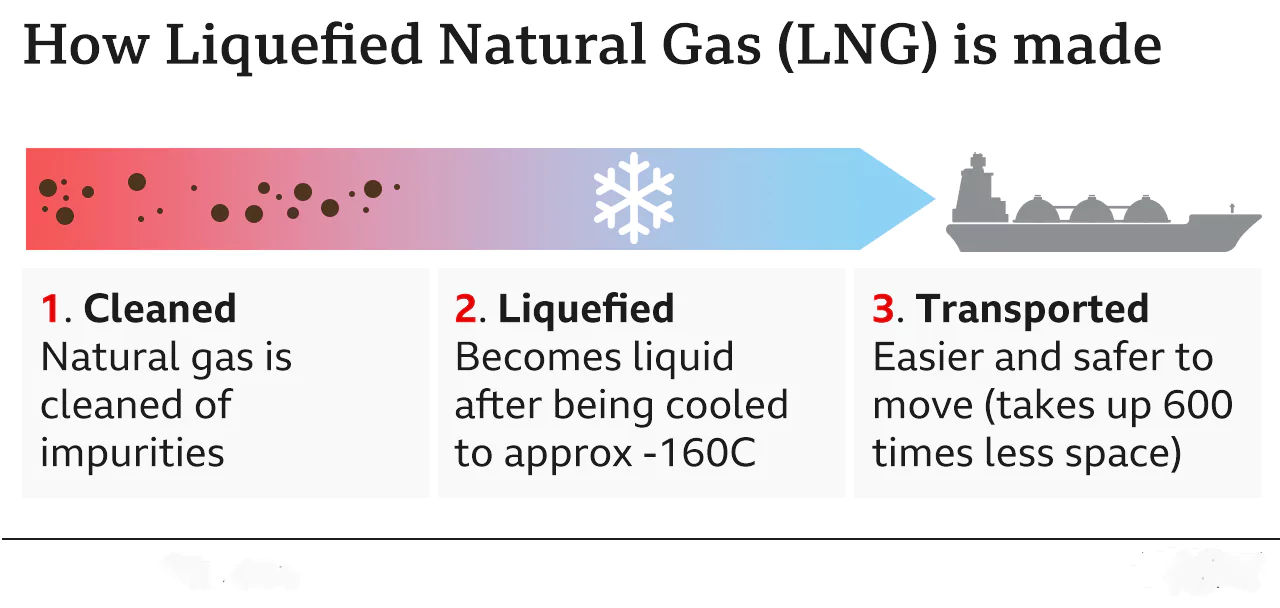 SSLNG provides LNG to businesses and industries either in its liquid form or when it’s super-chilled.
SSLNG provides LNG to businesses and industries either in its liquid form or when it’s super-chilled. 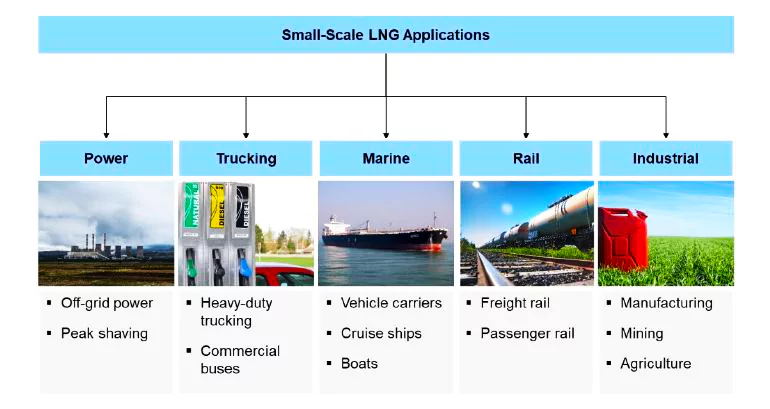 Underdeveloped Retail Infrastructure: A lack of extensive LNG retail networks makes it challenging for consumers to access LNG fuel easily.
Underdeveloped Retail Infrastructure: A lack of extensive LNG retail networks makes it challenging for consumers to access LNG fuel easily.| Feature | SSLNG (Small Scale LNG) | LNG (Liquefied Natural Gas) |
| Scale | Smaller liquefaction plants, lower capacity (less than 500,000 tons per year) | Larger liquefaction plants, much higher capacity (millions of tons per year) |
| Transportation | Cryogenic trucks, small vessels | Large LNG tankers |
| Target Market | Remote areas without pipeline infrastructure, specific fuel requirement industries, automotive fuel | Large-scale industrial users, power generation |
| Regasification | May or may not require regasification depending on end use | Requires regasification for pipeline distribution |
| Infrastructure | Lower investment needs, faster deployment | Higher investment needs, complex infrastructure |
News Source: Indianexpress
| Must Read | |
| NCERT Notes For UPSC | UPSC Daily Current Affairs |
| UPSC Blogs | UPSC Daily Editorials |
| Daily Current Affairs Quiz | Daily Main Answer Writing |
| UPSC Mains Previous Year Papers | UPSC Test Series 2024 |
Recently, Vikram Sarabhai Space Centre (VSSC), an ISRO Facility at Thumba, has developed a multi-purpose ‘SAKHI app’ that will help astronauts on Gaganyaan space flight mission.

News Source: THE HIndu
| Must Read | |
| NCERT Notes For UPSC | UPSC Daily Current Affairs |
| UPSC Blogs | UPSC Daily Editorials |
| Daily Current Affairs Quiz | Daily Main Answer Writing |
| UPSC Mains Previous Year Papers | UPSC Test Series 2024 |
Recently, the Reserve Bank of India launched the UDGAM Portal for unclaimed deposits in India.
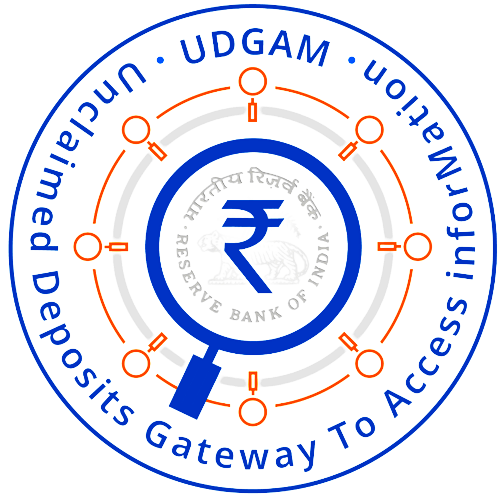 Launched by: RBI
Launched by: RBINews Source: BS
| Must Read | |
| NCERT Notes For UPSC | UPSC Daily Current Affairs |
| UPSC Blogs | UPSC Daily Editorials |
| Daily Current Affairs Quiz | Daily Main Answer Writing |
| UPSC Mains Previous Year Papers | UPSC Test Series 2024 |
The springtime festival of Nowruz marks the beginning of the Iranian or Persian New Year.
News Source: Indian Express
| Must Read | |
| NCERT Notes For UPSC | UPSC Daily Current Affairs |
| UPSC Blogs | UPSC Daily Editorials |
| Daily Current Affairs Quiz | Daily Main Answer Writing |
| UPSC Mains Previous Year Papers | UPSC Test Series 2024 |
Exercise Tiger Triumph, India, U.S. tri-Service Humanitarian Assistance and Disaster Relief (HADR) exercise is being held from 18th – 31st March, 2024.
News Source: The Hindu
| Must Read | |
| NCERT Notes For UPSC | UPSC Daily Current Affairs |
| UPSC Blogs | UPSC Daily Editorials |
| Daily Current Affairs Quiz | Daily Main Answer Writing |
| UPSC Mains Previous Year Papers | UPSC Test Series 2024 |
Recently the Intergovernmental Panel on Climate Change recently released its 6th Synthesis Report, which updated and summarized the IPCC’s sixth assessment cycle.
About Integrated Assessment Models (IAMs)
|
|---|
Intergovernmental Panel on Climate Change
|
|---|
News Source: The Hindu
| Must Read | |
| NCERT Notes For UPSC | UPSC Daily Current Affairs |
| UPSC Blogs | UPSC Daily Editorials |
| Daily Current Affairs Quiz | Daily Main Answer Writing |
| UPSC Mains Previous Year Papers | UPSC Test Series 2024 |
This Article is based on the news “Many elections, AI’s dark dimension” which was published in the Hindu. With a series of elections to be held worldwide in 2024, it is essential to recognise that artificial intelligence (AI) has the potential to disrupt democracy.
| Relevancy for Prelims: Artificial Intelligence, Global Partnership On Artificial Intelligence, India AI Mission, Global AI Summit 2023, New Delhi AI Declaration, Lok Sabha Election, and Election Commission Of India.
Relevancy for Mains: Use of AI in Elections: Significance, Challenges, and Concerns. |
|---|
About Artificial Intelligence (AI)
About Generative Artificial Intelligence (GAI)
|
|---|
 The ECI can use social media to disseminate relevant information like important dates for the new voter registration, date and time of voting, etc. It can also encourage first-time voters to participate in the democratic process.
The ECI can use social media to disseminate relevant information like important dates for the new voter registration, date and time of voting, etc. It can also encourage first-time voters to participate in the democratic process. | Deepfakes: These are digital media — video, audio, and images edited and manipulated using Artificial Intelligence (AI). |
|---|
|
|---|
The Future of AI-Centric Elections
|
|---|
This is an era where technological evolution is inevitable. Maintaining democratic principles whilst utilising technology for advancement calls for significant thought and constant ethical examination. The proper integration of social media and AI will influence political discourse and decision-making for years to come as Bharat moves towards the Amrit Kaal of its democracy.
| Prelims PYQ (2017):
Consider the following statements: 1. The Election Commission of India is a fivemember body. 2. Union Ministry of Home Affairs decides the election schedule for the conduct of both general elections and bye-elections. 3. Election Commission resolves the disputes relating to splits/mergers of recognized political parties. Which of the statements given above is/are correct? (a) 1 and 2 only (b) 2 only (c) 2 and 3 only (d) 3 only Ans: (d) |
|---|
| Mains Question: Enumerate various types of Artificial Intelligence (AI) & explain the potential applications of Generative AI for advancing India’s socio-economic development. (15 marks, 250 words) |
|---|
| Must Read | |
| NCERT Notes For UPSC | UPSC Daily Current Affairs |
| UPSC Blogs | UPSC Daily Editorials |
| Daily Current Affairs Quiz | Daily Main Answer Writing |
| UPSC Mains Previous Year Papers | UPSC Test Series 2024 |
This Article is based on the news “Heat, aridity, clear skies: why forests are already ablaze in the Nilgiris” which was published in the Indian Express. Forest fires have been raging in the Coonoor forest range in the Nilgiris in Tamil Nadu for almost a week.
| Relevancy for Prelims: Wildfires, Climate Change, Forest In India, Forest Conservation, and Classification And Types Of Disasters And Natural Hazards.
Relevancy for Mains: Forest Fires in India: Statistics, Causes, Impact, Management, Initiatives, and Way Forward. |
|---|
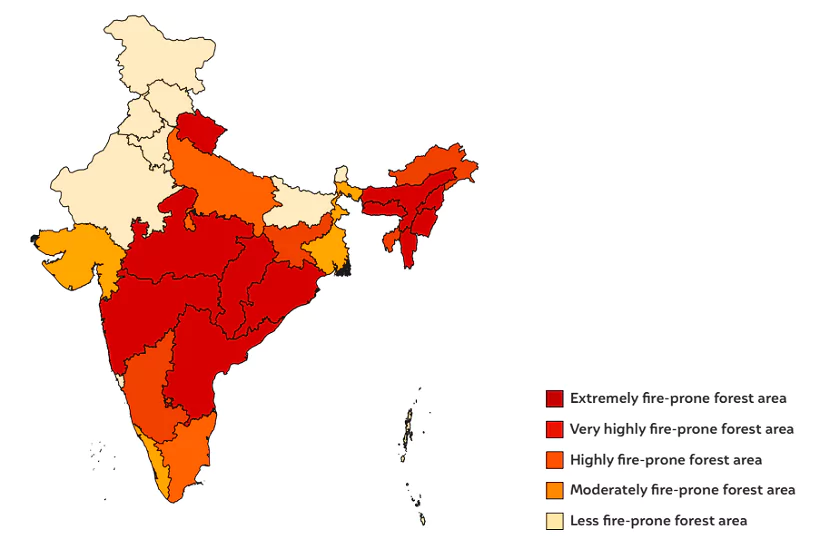 About 4% of the forest cover was ‘extremely prone’ to fire, and another 6% was ‘very highly’ fire prone.
About 4% of the forest cover was ‘extremely prone’ to fire, and another 6% was ‘very highly’ fire prone.Causes of Forest Fires in India are as follows;
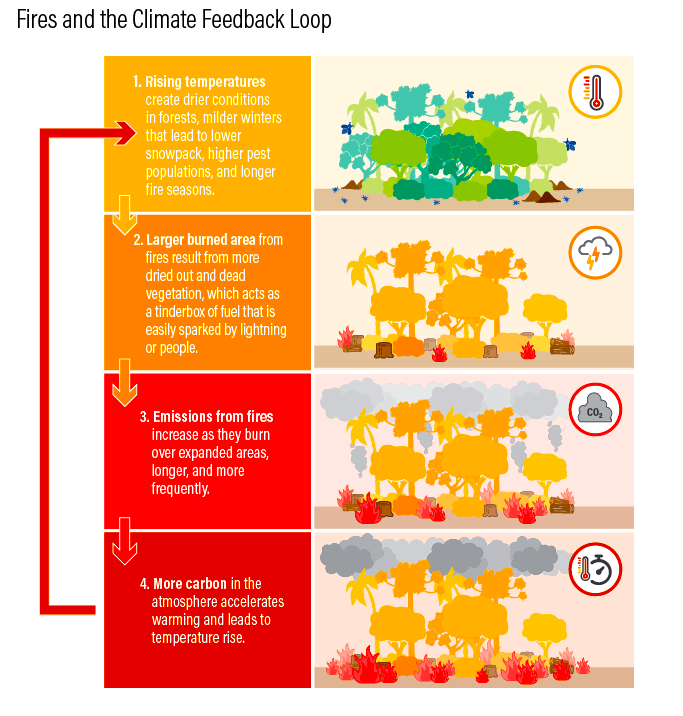
Measures Suggested by NAPFF
|
|---|
Institutional Set up for Forest Fire Management in India
Best Practices:
|
|---|
| Prelims PYQ (2021):
At the national level, which ministry is the nodal agency to ensure effective implementation of the Scheduled Tribes and Other Traditional Forest Dwellers (Recognition of Forest Rights) Act, 2006? (a) Ministry of Environment, Forest and Climate Change (b) Ministry of Panchayati Raj (c) Ministry of Rural Development (d) Ministry of Tribal Affairs Ans: (d) |
|---|
| Must Read | |
| NCERT Notes For UPSC | UPSC Daily Current Affairs |
| UPSC Blogs | UPSC Daily Editorials |
| Daily Current Affairs Quiz | Daily Main Answer Writing |
| UPSC Mains Previous Year Papers | UPSC Test Series 2024 |
<div class="new-fform">
</div>
